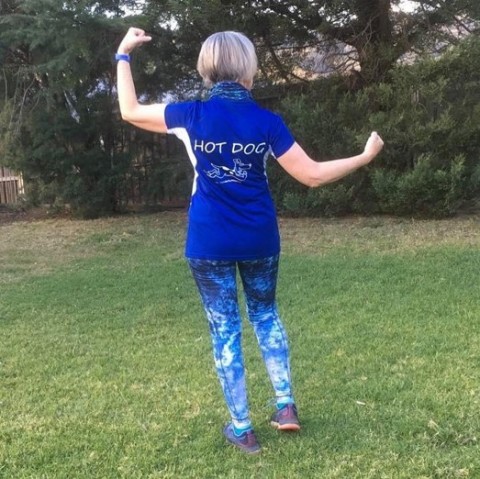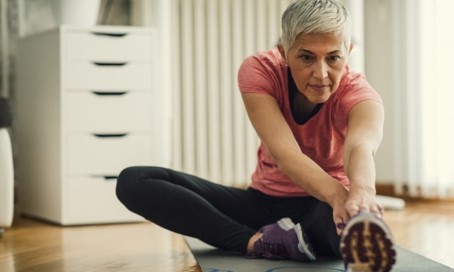Winner of the Winter Active Wear Competition
- Winner of the Winter Active Wear Competition
- Pilates Morning Tea With Your Pooch
- How To Manage Arthritis This Winter
We would like to say a big congratulations to our winner of the Winter Active Wear Competition! And that winner is none other than, Sandra Lanz! If you didn't read our last month's newsletter, the winner of the Winter Active Wear Competition receives 4 x mat classes for sending in a photo in some funky active wear. A huge congrats from us at the studio and thank you for taking part in some fun =P
Pilates Morning Tea With Your Pooch
It's time to get your paws out!
Ever thought about doing Pilates with your furry friend? Well now you can with Pilates Comes To You! We are offering a chance to bring in your pooch with you to a Pilates mat class at our studio, with the help of the RSPCA! We are offering two mat classes on Saturday 7th September, for you and your pooch! If you are interested please book online on our website @pilatescomestoyou.com.au, as spaces are filling fast. Times are 9am-10am and 11am-12pm, with a big morning tea in between, to help fundraise for the RSPCA!
There will be morning tea for you and your pooch, so please come along for some fun!
Classes are $20 per person, with money being sent to the RSPCA that works to prevent cruelty to animals by actively promoting their care and protection.
NOTE: Please make sure that your pooch is all up to date with vaccinations, and is friendly with other dogs and people, so that everyone can have a great time.
We can't wait to see you and your pooch there!
How To Manage Arthritis This Winter
What is Arthritis?
Arthritis is a medical condition that damages the body's joints, causing discomfort and pain. It can range from mild to severe and can affect people of all ages. Although there is usually no cure for arthritis, there are ways to manage the condition.
There are over 100 forms of arthritis. Each type of arthritis affects you and your joints in different ways. Some forms of arthritis can also involve other parts of the body such as the eyes.The most common forms of arthritis are:
•Osteoarthritis
•Rheumatoid arthritis
•Gout
•Ankylosing spondylitis
What are the symptoms?
Arthritis affects people in different ways but the most common symptoms are:
•Pain
•stiffness or reduced movement of a joint
•swelling in a joint
•redness and warmth in a joint
•general symptoms, such as tiredness, weight loss or feeling unwell.
Is my sore joint arthritis?
There are many different reasons why your joints may be sore. Not all pain in muscles and joints is caused by arthritis. It could be from an injury or using your joints and muscles in an unusual way (for example, playing a new sport or lifting heavy boxes). Talk to your doctor if you have pain and stiffness that:
•starts for no clear reason
•lasts for more than a few days
•comes on with swelling, redness and warmth of your joints.
How can I find out if I have arthritis?
See your doctor as soon as possible if you have symptoms of arthritis. Your doctor will ask you about your symptoms and examine your joints. They may do some tests or x-rays, but these can be normal in the early stages of arthritis. It may take several visits before your doctor can tell what type of arthritis you have. This is because some types of arthritis can be hard to diagnose in the early stages. Your doctor may also send you to a rheumatologist, a doctor who specialises in arthritis, for more tests.
Is there a cure for arthritis?
Currently there is no cure for most forms of arthritis. While there are treatments that can effectively control symptoms, you should be wary of any products or treatments that claim to cure arthritis.
Can arthritis be treated?
Many types of arthritis can be easily and effectively controlled by modern treatment. Early diagnosis and the right treatment can ease symptoms and may even prevent damage to your joints. Research has led to great improvements in this area. Because arthritis affects people in different ways, treatment has to be tailored to the needs of each person.
What can I do?
The good news is that there are many simple things you can do to live well with arthritis, but one very important one is to exercise and keep moving. Physical activity and exercise is extremely important for managing an arthritis condition. It can improve mobility and flexibility of joints, muscle strength posture, and balance.It can also decrease pain, fatigue (tiredness), muscle tension and stress.
Is physical activity good for arthritis?
Research has found that regular exercise is one of the most effective treatments for arthritis. It can help to:
•Improve mobility and flexibility of joints, muscle strength, posture and balance
•Decrease pain, fatigue (tiredness), muscle tension and stress
Just as importantly, physical activity will improve your overall health. It can improve the fitness of your heart and lungs, increase bone strength, reduce body weight and reduce the risk of conditions such as diabetes. It also improves your sleep, energy levels and mental well-being. Exercise is one of the best treatments for arthritis. Talk to your healthcare team before you get started.
What types of exercise should I do?
Before you start to exercise it is important to ask your doctor and healthcare team to help you develop a suitable program and choose the best activities for you. Everyone's fitness level and limitations will be different so start with activities that suit you. While some people with arthritis will find a five kilometre walk comfortable, others may find walking around the block difficult.
Generally you will need to do a mix of:
•flexibility: to maintain or improve the mobility of your joints and muscles. Examples include moving the joint as far as it can, muscle stretches and yoga.
•muscle strengthening: strong muscles help to support and take pressure off sore joints, strengthen bones and improve balance. An example is using weights, resistance bands or gym machines.
•fitness: to improve the health of your heart and lungs. These activities usually use the larger muscles in the body, rather than exercising a specific area, and may make you 'puff' a little. An example is brisk walking.
There isn't just one particular exercise or activity that is recommended for all people with arthritis. Choose an activity that you enjoy and that is convenient for you to do. Low-impact exercises, with less weight or force going through your joints, are usually most comfortable.
Examples of low-impact activities include:
•walking
•exercising in water, such as hydrotherapy (with a physiotherapist), swimming or water exercise classes
•strength training
•Tai chi
•yoga and pilates
•cycling
•dancing
Quote of the Month - "Blessed are the flexible, Because they will not be bent out of shape"
by Robert Ludlum




